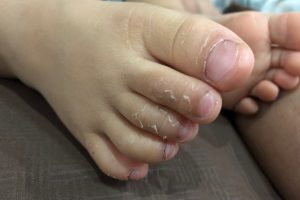The scent of a newborn baby is a topic that has long intrigued both parents and researchers.
This distinctive aroma is not just a source of fascination but also plays a crucial role in the bonding process between a parent and their child.
Biological Origins of Newborn Scent
The vernix caseosa, a waxy substance on a newborn’s skin, intricately connects to their unique scent. Composed mainly of water (about 80.5%), lipids, and proteins, this substance plays a vital role in preserving the baby’s skin moisture and acting as a protective barrier. The vernix caseosa’s high water content is mainly confined within fetal corneocytes, a specific type of skin cell. These corneocytes in the vernix differ significantly from mature corneocytes in adult skin, being swollen and less dense, and they lack tonofilament orientation to a certain degree, contributing to the vernix caseosa’s unique texture and function.
Contribution of Apocrine Glands
The role of apocrine glands in contributing to the unique scent of newborns is a fascinating aspect of neonatal biology. While the research specifically linking apocrine gland activity to newborn scent is limited, insights can be drawn from the general understanding of these glands.
Apocrine glands begin significant development in the late stages of pregnancy. These glands are known for their unique secretion process, involving the pinching off of the apical part of the cell. In adults, apocrine glands are associated with scent production. The secretions from these glands are initially odorless but can develop a scent when broken down by bacteria. This is particularly noticeable in areas like the underarms. In newborns, while the apocrine glands are less active than in adults, it’s possible that they contribute to the overall scent profile, especially considering the unique environment of a newborn’s skin.
The Role of Newborn Scent in Parent-Child Bonding
The unique scent of newborn babies plays a pivotal role in the bonding process between a parent and their child. Research has shown that the scent of a baby can trigger significant responses in the brains of parents, akin to responses triggered by other rewarding stimuli.
Mothers can typically recognise and show a preference for the odour of their own baby. This preference is associated with the bonding process between mother and child. A study found that healthy mothers showed a clear preference for their own baby’s scent compared to others, whereas mothers with bonding difficulties did not show this preference. This suggests that the infant’s body odour plays a role in strengthening the mother-child bond.
Expanding further, the scent of newborns triggers dopamine pathways in a brain region linked to reward learning in women, with a notably stronger response in mothers than non-mothers. A recent study using functional Magnetic Resonance Imaging (fMRI) observed brain activity in women exposed to newborns’ smell. The results suggest that the newborn scent induces a pleasure and reward response in the brain, akin to the response caused by satisfying food or even addictive substances.
Moreover, a mother’s scent not only helps infants bond with her but also with others. Research found that infants exposed to their mother’s scent exhibited more relaxed behavior, smiled more, and engaged in more eye contact with strangers. This shows that a mother’s scent can aid a child’s social and emotional development, even when the mother is not present.
Evolutionary Perspectives
The evolutionary basis for the unique scent of newborns is a fascinating area of study. It intertwines aspects of biology, psychology, and anthropology. The prevailing hypothesis is that the newborn scent plays a significant role in ensuring the survival and well-being of the infant. Seemingly strengthening the bond between parents (especially mothers), and their child.
From an evolutionary standpoint, traits that boost offspring survival are likely to be preferred. The pleasant scent of newborns might have evolved as a way to attract parents to their infants. This promotes physical closeness and caregiving. This bond is essential in humans, where infants rely completely on adult care for an extended time.
Furthermore, evolutionary biologists and psychologists propose that infants’ multisensory cues. This includes their scent, visual appearance, and sounds. Jointly, it creates the “cuteness” factor that triggers a caregiving response from adults. This response goes beyond biological parents. It encompasses other adults, which shows a wider social role of infantile traits in human communities.
It’s crucial to acknowledge that, although current research supports these hypotheses, the field of evolutionary biology is constantly progressing. More research in this domain is necessary to thoroughly grasp the complexities of how and why traits like the newborn scent have evolved over time in the context of human evolution.
The Newborn Scent and Its Impact
This unique aroma plays a vital role far beyond mere olfactory pleasure. It emerges as a key factor in establishing and strengthening the bond between parent and child, likely honed by evolutionary processes. This scent activates regions in the adult brain associated with reward and pleasure. It enhances caregiving behaviours crucial for the survival and development of the infant.
This phenomenon extends beyond biological mothers and manifests universally in women. In fact, it indicates a wider social and evolutionary role of the newborn scent in human societies. The complex interaction of biology and evolutionary adaptation vividly demonstrates how nature guarantees the sustenance and nurturing of human life from its very beginning.
Therefore, the newborn scent serves as a testament to the intricate and delicate balance of nature’s design, ensuring that the community at large, not just the parents, cares for and protects the most vulnerable among us.
As we continue to unravel the mysteries of human development and evolution, the newborn scent remains a fascinating subject of study, embodying the profound connections that bind us together from the very beginning of life.
References
- Pickens, W. L., Warner, R., Boissy, Y. L., Boissy, R. E., & Hoath, S. B. (2000, November 1). Characterization of Vernix Caseosa: Water Content, Morphology, and Elemental Analysis. Journal of Investigative Dermatology. https://doi.org/10.1046/j.1523-1747.2000.00134.x
- Croy, I., Mohr, T., Weidner, K., Hummel, T., & Junge-Hoffmeister, J. (2019, January 1). Mother-child bonding is associated with the maternal perception of the child’s body odor. Physiology & Behavior. https://doi.org/10.1016/j.physbeh.2018.09.014
- Hodge BD, Sanvictores T, Brodell RT. Anatomy, Skin Sweat Glands. [Updated 2022 Oct 10]. In: StatPearls [Internet]. Treasure Island (FL): StatPearls Publishing; 2024 Jan-. Available from: https://www.ncbi.nlm.nih.gov/books/NBK482278/
- Murphrey MB, Safadi AO, Vaidya T. Histology, Apocrine Gland. [Updated 2022 Oct 10]. In: StatPearls [Internet]. Treasure Island (FL): StatPearls Publishing; 2024 Jan-. Available from: https://www.ncbi.nlm.nih.gov/books/NBK482199/













